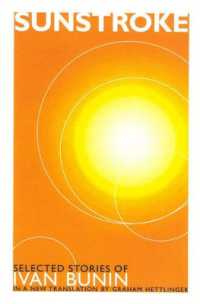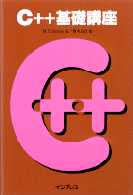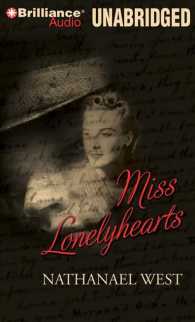- ホーム
- > 洋書
- > 英文書
- > Literary Criticism
Full Description
In the eighteenth century, British Methodism was an object of both derision and desire. Many popular eighteenth-century works ridiculed Methodists, yet often the very same plays, novels, and prints that cast Methodists as primitive, irrational, or deluded also betrayed a thinly cloaked fascination with the experiences of divine presence attributed to the new evangelical movement. Misty G. Anderson argues that writers, actors, and artists used Methodism as a concept to interrogate the boundaries of the self and the fluid relationships between religion and literature, between reason and enthusiasm, and between theater and belief. "Imagining Methodism" situates works by Henry Fielding, John Cleland, Samuel Foote, William Hogarth, Horace Walpole, Tobias Smollett, and others alongside the contributions of John Wesley, Charles Wesley, and George Whitefield in order to understand how Methodism's brand of "experimental religion" was both born of the modern world and perceived as a threat to it. Anderson's analysis of reactions to Methodism exposes a complicated interlocking picture of the religious and the secular, terms less transparent than they seem in current critical usage.
Her argument is not about the lives of eighteenth-century Methodists; rather, it is about Methodism as it was imagined in the work of eighteenth-century British writers and artists, where it served as a sign of sexual, cognitive, and social danger. By situating satiric images of Methodists in their popular contexts, she recaptures a vigorous cultural debate over the domains of religion and literature in the modern British imagination. Rich in cultural and literary analysis, Anderson's argument will be of interest to students and scholars of the eighteenth century, religious studies, theater, and the history of gender.
Contents
Acknowledgments
Introduction: Longing to Believe: Methodism and Modernity
1. Historicizing Methodism
2. The New Man: Desire, Transformation, and the Methodist Body
3. Words Made Flesh: Fanny Hill and the Language of Passion
4. Actors and Ghosts: Methodism in the Theater of the Real
5. "My Lord, My Love": The Performance of Public Intimacy and the Methodist Hymn
6. A Usable Past: Reconciliation in Humphry Clinker and The Spiritual Quixote
Afterword: 1778 and Beyond
Notes
Bibliography
Index








